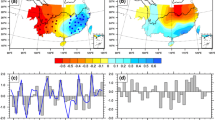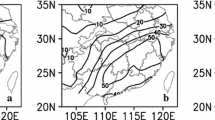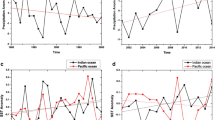Abstract
December–January–February (DJF) rainfall variability in southeastern South America (SESA) is studied in 18 coupled general circulation models from the WCRP/CMIP3 dataset, for present climate and the SRES-A1B climate change scenario. The analysis is made in terms of properties of the first leading pattern of rainfall variability in the region, characterized by a dipole-like structure with centers of action in the SESA and South Atlantic Convergence Zone (SACZ) regions. The study was performed to address two issues: how rainfall variability in SESA would change in a future climate and how much of that change explains the projected increasing trends in the summer mean rainfall in SESA identified in previous works. Positive (negative) dipole events were identified as those DJF seasons with above (below) normal rainfall in SESA and below (above) normal rainfall in the SACZ region. Results obtained from the multi-model ensemble confirm that future rainfall variability in SESA has a strong projection on the changes of seasonal dipole pattern activity, associated with an increase of the frequency of the positive phase. In addition, the frequency increase of positive dipole phase in the twenty first century seems to be associated with an increase of both frequency and intensity of positive SST anomalies in the equatorial Pacific, and with a Rossby wave train-like anomaly pattern linking that ocean basin to South America, which regionally induces favorable conditions for moisture transport convergence and rainfall increase in SESA.














Similar content being viewed by others
References
Berbery EH, Barros V (2002) The hydrological cycle of the La Plata Basin in South America. J Hydrometeorol 3:630–645
Cerne B, Vera C (2010) Influence of the intraseasonal variability on heat waves in subtropical South America. Clim Dyn (in press)
Christensen JH, Hewitson B, Busuioc A, Chen A, Gao X, Held I, Jones R, Kolli RK, Kwon W-T, Laprise R, Magaña Rueda V, Mearns L, Menéndez CG, Räisänen J, Rinke A, Sarr A, Whetton P (2007) Regional climate projections. In: Solomon S, Qin D, Manning M, Chen Z, Marquis M, Averyt KB, Tignor M, Miller HL (eds) Climate change 2007: the physical science basis. Contribution of working group I to the fourth assessment report of the intergovernmental panel on climate change. Cambridge University Press, Cambridge, United Kingdom and New York, NY, USA
Delworth T et al (2006) GFDL’s CM2 global coupled climate models—part 1: formulation and simulation characteristics. J Clim 19:643–674
Doyle ME, Barros VR (2002) Midsummer low-level circulation and precipitation in subtropical South America and related sea surface temperature anomalies in the South Atlantic. J Clim 15:3394–3410
Flato GM (2005) The third generation coupled global climate model (CGCM3) (and included links to the description of the AGCM3 atmospheric model). http://www.cccma.bc.ec.gc.ca/models/cgcm3.shtml
Gandu AW, Silva Dias PL (1998) Impact of tropical heat sources on the South American tropospheric upper circulation and subsidence. J Geophys Res 103:6001–6015
Giorgi F (2002) Variability and trends of sub-continental scale surface climate in the twentieth century. Part I: observations. Clim Dyn 18:675–691
Gordon C et al (2000) The simulation of SST, sea ice extents and ocean heat transports in a version of the Hadley Centre coupled model without flux adjustments. Clim Dyn 16:147–168
Gordon HB et al (2002) The CSIRO Mk3 climate system model. CSIRO Atmospheric Research Technical Paper No. 60. Commonwealth Scientific and Industrial Research Organisation Atmospheric Research, Aspendale, Victoria, Australia. http://www.cmar.csiro.au/e-print/open/gordon_2002a.pdf
Grimm A, Zilli MT (2009) Interannual variability and seasonal evolution of summer monsoon in South America. J Clim 22:2257–2275
Grimm A, Barros VR, Doyle ME (2000) Climate variability in southern South America associated with El Niño and La Niña events. J Clim 13:35–58
Guilyardi E (2006) El Niño-mean state-seasonal cycle interactions in a multi-model ensemble. Clim Dyn 26(4):329–348
Hasumi H et al (2004) K-1 coupled GCM (MIRCO) description. K-1 technical report no. 1, 34 pp. Available at http://www.ccsr.u-tokyo.ac.jp/kyosei/hasumi/MIROC/techrepo.pdf
Hawkins E, Sutton RT (2009) The potential to narrow uncertainty in regional climate predictions. Bull Am Meteorol Soc 90(8):1095–1107. ISSN 1520-0477
IPCC (2007) Summary for policymakers. In: Solomon S, Qin D, Manning M, Chen Z, Marquis M, Averyt KB, Tignor M, Miller HL (eds) Climate change 2007: the physical science basis. Contribution of working group I to the fourth assessment report of the intergovernmental panel on climate change. Cambridge University Press, Cambridge, United Kingdom and New York, NY, USA
Johns TC et al (2006) The new Hadley Centre climate model HadGEM1: evaluation of coupled simulations. J Clim 19:1327–1353
Jungclaus JH et al (2006) Ocean circulation and tropical variability in the AOGCM ECHAM5/MPI-OM. J Clim 19:3952–3972
Knutti R (2010) The end of model democracy? An editorial comment. Clim Chang 102:395–404
Kodama Y-M (1992) Large-scale common features of subtropical precipitation zones (the Baiu Frontal Zone, the SPCZ, and the SACZ). Part I: characteristics of subtropical frontal zones. J Meteorol Soc Jpn 70:813–835
Leloup J, Lengaigne M, Boulanger JP (2008) Twentieth century ENSO characteristics in the IPCC database. Clim Dyn 30:277–291
Li ZX, Le Treut H (1999) Transient behavior of the meridional moisture transport across South America and its relation to atmospheric circulation patterns. Geophys Res Lett 26:1409–1412
Marti O et al (2005) The new IPSL climate system model: IPSL-CM4. Note du Pôle de Modélisation No. 26. Institut Pierre Simon Laplace des Sciences de l’Environnement Global, Paris. http://dods.ipsl.jussieu.fr/omamce/IPSLCM4/DocIPSLCM4/FILES/DocIPSLCM4.pdf
Marengo JA, Liebmann B, Grimm AM, Misra V, Silva Dias PL, Cavalcanti IFA, Carvalho LMV, Berbery EH, Ambrizzi T, Vera CS, Saulo AS, Nogues-Paegle J, Zipser E, Seth A, Alves LM (2010) Recent developments on the South American monsoon system. Accepted in Int J Climatol
Meehl G, Covey C, Taylor KE, Delworth T, Stouffer RJ, Latif M, McAvaney B, Mitchell JFB (2007) THE WCRP CMIP3 multimodel dataset: a new era in climate change research. Bull Am Meteorol Soc 88:1383–1394
Min S-K, Legutke S, Hense A, Kwon W-T (2005) Climatology and internal variability in a 1000-year control simulation with the coupled climate model ECHO-G—I. Near-surface temperature, precipitation and mean sea level pressure. Tellus 57A:605–621
Nakicenovic N et al (2000) Special Report on Emissions Scenarios. In: Nakicenovic N, Swart R (eds) Cambridge Univ Press, New York
Nogués-Paegle J, Mo K (1997) Alternating wet and dry conditions over South America during summer. Mon Weather Rev 125:279–291
Paegle JN, Mo KC (2002) Linkages between summer rainfall variability over South America and sea surface temperature anomalies. J Clim 15:1389–1407
Robertson AW, Mechoso CR (2000) Interannual and interdecadal variability of the South Atlantic convergence zone. Mon Weather Rev 128:2947–2957
Rodwell MR, Hoskins BJ (2001) Subtropical anticyclones and summer monsoons. J Clim 14:3192–3211
Russell GL (2005) 4×3 atmosphere-ocean model documentation. http://aom.giss.nasa.gov/doc4x3.html
Salas-Melia D, Chauvin F, Deque M, Douville H, Gueremy J, Marquet P, Planton S, Royer J, Tyteca S (2005) Description and validation of the CNRM-CM3 global coupled model. CNRM working note 103
Schmidt GA et al (2006) Present day atmospheric simulations using GISS ModelE: comparison to in situ, satellite and reanalysis data. J Clim 19:153–192. http://www.giss.nasa.gov/tools/modelE/
Silvestri G, Vera C (2008) Evaluation of the WCRP-CMIP3 model simulations in the La Plata Basin. Meteorol Appl 15:497–502
van Oldenborgh G, Philip S, Collins M (2005) El Niño in changing climate: a multi-model study. Ocean Sci 1:81–95
Vera C, Silvestri G (2009) Precipitation interannual variability in South America from the WCRP-CMIP3 multi-model dataset. Clim Dyn 32:1003–1014
Vera CS et al (2006a) Toward a unified view of the American monsoon systems. J Clim 19:4977–5000, WN: 0628807462003
Vera CS, Silvestri G, Liebmann B, Gonzalez P (2006) Climate change scenarios for seasonal precipitation in South America from IPCC-AR4 models. Geophys Res Lett 33:L13707. doi:10.1029/2006GL025759
Volodin EM, Diansky NA (2004) El-Niño reproduction in a coupled general circulation model of atmosphere and ocean. Russ Meteorol Hydrol 12:5–14
Xie P, Arkin PA (1997) Global precipitation: a 17-year monthly analysis based on gauge observations, satellite estimates, and numerical model outputs. Bull Am Meteorol Soc 78:2539–2558
Yukimoto S et al (2006) Present-day climate and climate sensitivity in the Meteorological Research Institute Coupled GCM, Version 2.3 (MRI-CGCM2.3). J Meteorol Soc Jpn 84:333–363
Acknowledgments
Comments and suggestions provided by two anonymous reviewers were very helpful in improving this paper. We acknowledge the international modeling groups for providing their data for analysis, the Program for Climate Model Diagnosis and Intercomparison (PCMDI) for collecting and archiving the model data, the JSC/CLIVAR Working Group on Coupled Modeling (WGCM) and their Coupled Model Intercomparison Project (CMIP) and Climate Simulation Panel for organizing the model data analysis activity, and the IPCC WG1 TSU for technical support. The IPCC Data Archive at Lawrence Livermore National Laboratory is supported by the Office of Science, U.S. Department of Energy. This research was supported by the European Commission’s Seventh Framework Programme (FP7/2007–2013) under Grant Agreement N° 212492 (CLARIS LPB. A Europe-South America Network for Climate Change Assessment and Impact Studies in La Plata Basin) and CONICET/PIP-5400. The first author C.J. is supported by a Ph.D grant from the Ecole Polytechnique.
Author information
Authors and Affiliations
Corresponding author
Rights and permissions
About this article
Cite this article
Junquas, C., Vera, C., Li, L. et al. Summer precipitation variability over Southeastern South America in a global warming scenario. Clim Dyn 38, 1867–1883 (2012). https://doi.org/10.1007/s00382-011-1141-y
Received:
Accepted:
Published:
Issue Date:
DOI: https://doi.org/10.1007/s00382-011-1141-y




